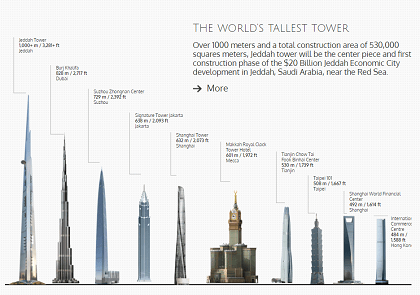The world’s tallest building, the Burj Khalifa in Dubai, is about to be dethroned. 1,200 miles away, a new tower is nearing its completion in Saudi Arabia. In 2020, the tallest building in the world, the Jeddah Tower measuring in at one kilometer, will open. That is if engineers can complete the audacious towering skyscraper on the desert sand.
The tower’s construction is estimated to cost the Kingdom Holding Company around US$1.5 billion. Jeddah Economic Company website initially reported that the tower would stretch “over 1000 meters” but Engineering360 says those plans have changed. Nonetheless, the tower will also have the world’s highest observatory deck ever built.
The tower will also be the centerpiece of an almost Singaporean city, a center for business and commerce. This city will be called the Jeddah Economic City. The entire district is to cost US$20 billion. It will include a new airport and cutting-edge infrastructure, replacing the dated and aging infrastructure Saudi Arabia has become synonymous for.
Building on sand
Whilst building a kilometer high building is obviously an engineering challenge, another engineering conundrum is how to build on the fine sand in Saudi Arabia. Civil engineers have had to closely study the 5 subsurface layers of the sand in Jeddah.
Geographically the tower is near the Red Sea.
Roger Pink from IEEE Global Spec’s Engineering360 explains:
“The first layer, varying from half a meter to 2 meters thick consists of silty sand. The next 40 to 50 meters is coralline limestone, followed by a 2 to 10-meter thick mudstone/gravel layer. Next comes a poorly constituted sandstone layer about 35 to 50 meters thick, followed by another 3 to 9-meter gravel layer. Finally, below all of this is a sandstone layer as far as 200 meters.”
The unique challenges have been figuring out how to utilize the architecture blueprints and build sturdily according to those designs. The architect for the project is American born Adrian D. Smith - coincidentally the architect behind the Burj Khalifa in Dubai. He is also responsible for the Trump International Hotel & Tower in Chicago, the Jin Mao Tower in Shanghai and the Zifeng Tower in Nanjing.
The engineers have created a three-winged load-bearing design. This design also has to account for wind and the pressures that it brings. The project began construction in 2013, but a series of delays has led to the most recent end-goal which is 2020.
One of the delays arose because of the height of the Jeddah Tower. Civil engineering experts advised the architects that the higher up they go, the more unstable the concrete becomes. That high up, the wind load would cause the concrete to shrink under the pressure. (This has also meant the construction has had to be as aerodynamic as possible.)
Specialized concrete pumping equipment with thin, pressurized pipes is being utilized to counteract the forces of gravity on the concrete. Pumping wet concrete a mile in the sky is allegedly the most challenging element of the construction.
The engineers have had to work later in the evenings at lower temperatures. This allows the concrete - being pushed out a single tube - to set. However, concrete is not the only thing that needs particular attention - transporting humans to the top of the tower will be a challenge too.
Bart Leclercq, head of structures for WSP Middle East, explains:
“You have to make sure a tower is not too flexible and people aren’t getting nauseous in high winds. You have to put enough stiffening elements in your building. For example, sheer walls in combination with concrete cores in the case of a concrete building.”
A novel approach to an elevator system is being drawn up to ensure the elevators do not suffer under the wind loads and the building sway. The tower is expected to have a wholly different elevator system - the first of its kind in the world.
The engineering challenges and the feasibility of a mile-high tower have meant that the architect’s original plans have, in some instances, changed to accommodate the actual construction of the tower.
Hisham Jomah, chief development officer at JEC, told the Times of Oman:
“Between theory and application: what has been designed and what is actually on site is quite another world.”
This year, over 50 percent of the construction is reportedly completed. Here is a video of the progress made on the tower in the first half of 2018:
To see how six cranes will contribute to the construction of the Kingdom Tower Jeddah, take a look at this construction simulation:
The entire project is a marvel of engineering from construction phase to completion. And as far as tall buildings go, in 2020 this tower will have reset the bar. It does, however, make one wonder at the significance of it all?
Works Cited
“Home Page.” Times of Oman, NEWSPAPER_NAME, timesofoman.com/.
Pink, Roger. “Jeddah Tower - Building a Skyscraper on Sand.” A Water Treatment Alternative to Chlorine? | Engineering360, insights.globalspec.com/article/8791/jeddah-tower-building-a-skyscraper-on-sand.
_TWIITERID. “Jeddah Economic Company | Home.” Http://Www.jec.sa//, www.jec.sa/.
Ephgrave, Oliver. “Tall Order.” ConsrtuctionWeekOnline.com, www.constructionweekonline.com/article-13533-tall-order/.
